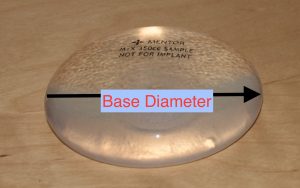‘I need recommendations on what breast implant size in ccs to get for my body Frame? I am 26 years old, 5′ 4” and 105 lbs and bra size 32A.,95lbs,bra size a/32. I can’t decide between silicone gel implants of 400cc or 450cc high profile size?’
‘Is 400cc silicone gel breast implants too large for my 5′ 6” 130lb frame with 32B breasts? What bra size do you think they will be afterwards?’
‘How many breast implant ccs to achieve this look? I am 32 years old, 5′ 7”, 125lbs, 29 inch rib cage, and s 34B bra.. I have some breast tissue but my skin is very fairly thin and my breast folds aren’t even, one sits higher than the other and one breast is larger.’
These are very typical questions that every breast augmentation patient asks. They may present with different iterations in age and body and breast sizes, but the fundamental question is the same…what size implant do I need for my desired breast look?
The simple answer is that there is no easy formula or one single method that can assure any woman how any size implant will look on their body. While breast implants have predictable sizes based on volume, a woman’s chest is anatomically variable. Chest width and shape, breast base width, amount of breast skin and quality, size and position of the nipple-areolar complex, and the overall body frame all influence how any breast implant size will look. In short, selecting breast implant size is not an exact science. This is also complicated by differing perspectives, plastic surgeons think about implants in cc volumes while women think in terms of bra cup sizes.
But there are helpful concepts and considerations in selecting implant size for those considering breast augmentation. There are four specific criteria/concepts that I look for and use in helping my patients through this process. It is a mixture of objective measurement, visual imagery and volumetric concepts.

Many women, as above, present their height and weight measurements as a consideration for breast augmentation. While these numbers imply what one’s body frame looks like, they do not indicate how any specific breast implant size will look on it. Thus these measurements are not really that useful. The same can be said for desired cup size. There is no known correlation between breast implant volume and cup size in any specific patient. There are just too many variables. Plus, if you have never been a C or D cup, for example, how do you really know what that is?
What does matter is what one sees as the breast size that they like. In other words, what do you want it to look like? Throw all numbers and cup sizes aside and focus on the visual image of the final result. This requires one to convey that image to their plastic surgeon. This is best done by looking at after surgery photos of breast augmentation surgeries and picking a few that you like. These can be found all over the internet but one manufacturer’s website, Love Your Look, is as good as any. These images tell me whether the size a patient wants matches that of her breast base width or whether it should be bigger.
When it comes to breast implant volumes, it is not relevant to debate between small volume differences such as 25cc or 50ccs in implant size. On a volumetric ratio basis, for example, the difference between 400cc and a 450cc implant is 12.5% in size. This is barely visible on the outside in most women. What usually matters is volume differences of greater than 50ccs, often much greater like 75cc or 100ccs. When debating between two implant sizes, it is almost always better to choose the bigger size. While most women are happy with their breast augmentation outcomes, most will say that they wouldn’t have minded being a little bigger.
Dr. Barry Eppley
Indianapolis, Indiana


